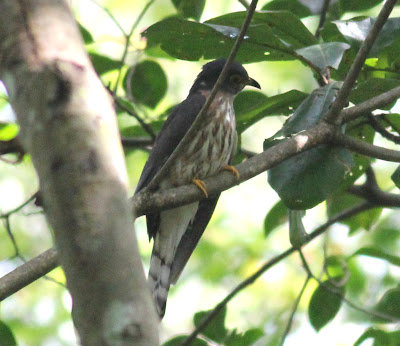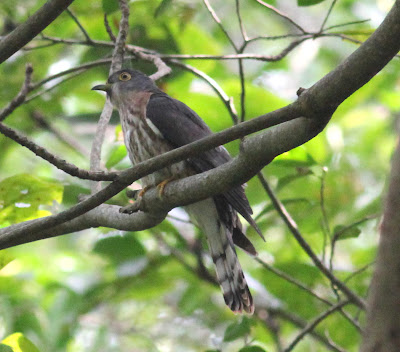Here we go again. This time i was in KSNP with a Swedish couple where the husband is a fan of Mark Knopfler from a British rock group named Dire Straits - remember the song "Sultan of Swing" during the early 80s! Not bad for a 60+ year old guy. There were not many "white birds" at this time but this place was never short of surprises.
First bird seen was this raptor, perched quite low near the trail. By late morning it was seen circling up in the sky.
 |
| Crested-Serpent Eagle |
A nice flight formation from a group of Purple Heron
One of the only hand full of "white birds" seen.
Quite an agressive raptor as we saw it disturbing some Pacific Swallows near the abandoned bird house.
Saw plenty of them this time.
There were many books out there describing its facial features around its eyes with words such as "orbital skin", "facial skin", "red skin around its eyes" etc. It was at this moment i realised that the facial "skin" was actually consisted of a group of fine and tiny hairs.
I was able to see the tiny hairs from my bins as well as from this photo as the bird was just a hand length away from us.
This time i had the opportunity to view two resident cuckoo birds. The first cuckoo bird was the Little Bronze Cuckoo which was easier to id despite having a back-focus problem with my camera.
When i saw this cuckoo bird i immediately knew that i had to take a few good photos in order to id this controversial bird.
From the many literature notes and photos taken, there was only one feature from the above photos which could differentiate this bird from H.fugax (Malaysian Hawk Cuckoo) i.e the greyer color on the top of this bird as compared to the more brownish color of H.fugax - Malaysian Hawk Cuckoo ). Other variations such as white patch on wings, and narrow/even tail bars seem to be similar with both birds. So for the moment i would think that the above cuckoo bird was a Hodgson's Hawk Cuckoo (H.nisicolor). As compared to the little bronze cuckoo, this cuckoo bird was completely silent.
Note: From the photos in the OBC and the statement from Robson's field guide which stated that nisicolor is greyer above than the Malaysian Hawk Cuckoo as well as the absence of the white patch on its nape and the rufous brown streaks (although the rufous color cannot be clearly seen here) i strongly believe that the above bird was actually a Hodgson Hawk Cuckoo. For a better understanding on the comparison of both the two cuckoo birds (H.fugax and H. nisicolor) you may refer to A write up by Con Foley dated October 6 2013 in his blog and some splendid photos and info from Dave Bakewell from a post in his blog dated Feb 28, 2014 )
In addition to birds i could not resist taking photos of the other inhabitants of KSNP. Here were some of them. Enjoy :)
These are fiddler crabs i believe.
The eye of a dragon !
A sun bathing green lizard
Do visit this place once a while if you have the time as it could spring some surprises or provide something for all the possible wildlife which you have wished to look for.




































